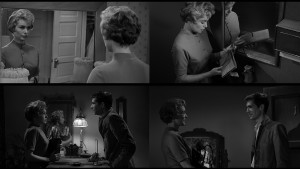In the book What You See in the Dark, there are many references to outside music and movie sources creating a unique ambiance to the setting. Some of the films mentioned are Vertigo, a Hitchcockian ‘who dun it?’ thriller as well, and George Stevens 1956 Giant, which is a southern gothic film of racial tensions in the southwest borderlands. These films have a lot to do with the setting of What You See in the Dark by linking the novel to these canny and dark references.
On a lighter note the music that circulated around the scenes in What You See in the Dark differentiates itself from the film Psycho. Teresa listens and sings lighthearted songs of “after love has left” country style blues from Patsy Cline and other artists. Patsy Cline’s popular “Walking After Midnight” and The Flamingo’s “I Only Have Eyes for You” also sung by Frank Sinatra. Through Teresa’s character as a singer we experience a mix of sounds in the novel from the well known soundtrack of Psycho’s “screaming violins” in its suspenseful moments to sounds of Elvis Presley and Peggy Lee, “She studied the album covers pasted up against the windows, Elvis Presley and Peggy Lee and Frank Sinatra, the black discs hanging down from the ceiling on fish line, each of them with colorful labels that Teresa regarded as if they were jewels”(Munoz,113). Little Anthony’s “Tears on My Pillow” also comes up with relevant lyrics to the story of pain and broken hearts.
Meanwhile Psycho’s soundtrack is composed of a darker, more ominous score made completely for strings by Bernard Herman, the brilliant composer of five of Hitchcock’s films, being a violin player himself. “For Psycho, Bernard Hermann was to concoct nothing less than a cello and violin masterwork, “black and white” music that throbbed sonorously as often as it gnawed at the nerve endings. The score would prove to be a summation of all of Hermann’s previous scores for Hitchcock’s films, conveying as it did the sense of the abyss that is the human psyche, dread, longing, regret in short, the wellsprings of the Hitchcock universe”(Rebello,wb). The music in Psycho comes up as a potential score for What You See in the Dark towards the end with the violent murder of Teresa. As the mother debates with herself whether to cover up for her son or not, the intense moments of her human psyche are revealed linking those climactic moments to the “screaming violins” of Hitchcock’s Psycho.
Works Cited
Munoz, Manuel. What You See in the Dark. Algonquin Books of Chapel Hill, North Carolina,1991. Print.
http://filmsound.org/articles/hitchcock/makingpsycho.htm Excerpt from Rebello, Stephen: Alfred Hitchcock and the Making of Psycho St Martins Pr (Trade); 1999
